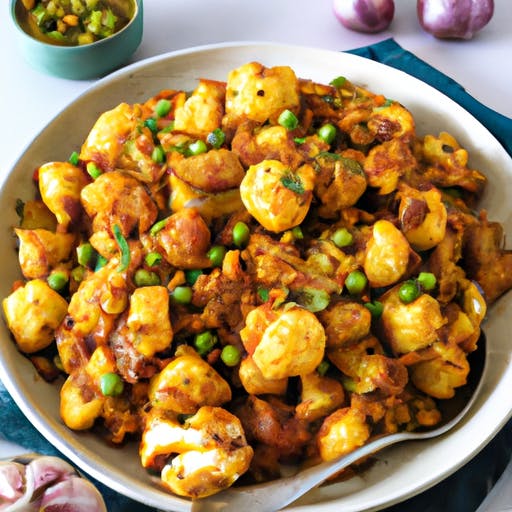
Ingredients:
Vegetables:
- 2 medium potatoes, diced (200 calories, $0.50)
- 1 small cauliflower, cut into florets (100 calories, $1.00)
- 1 small onion, finely chopped (50 calories, $0.25)
- 2 cloves garlic, minced (10 calories, $0.10)
- 1-inch ginger, grated (5 calories, $0.10)
- 2 tomatoes, chopped (50 calories, $0.50)
Spices:
- 1 teaspoon cumin seeds (5 calories, $0.05)
- 1 teaspoon turmeric powder (5 calories, $0.05)
- 1 teaspoon coriander powder (5 calories, $0.05)
- 1/2 teaspoon red chili powder (2 calories, $0.02)
- Salt to taste (0 calories, negligible cost)
- Fresh cilantro leaves, for garnish (5 calories, $0.10)
Cooking oil:
- 2 tablespoons vegetable oil (240 calories, $0.20)
Total Calories: 767
Total Cost: $2.82 (rounded to $2.80)
Total Cook Time: 35 minutes
Total Servings: 4
Instructions:
- Prepare the Vegetables: Start by preparing all your ingredients. Peel and dice the potatoes into bite-sized cubes. Cut the cauliflower into florets, making sure to remove any tough stems. Finely chop the onion and garlic, and grate the ginger. Chop the tomatoes into small pieces as well. Having all your ingredients prepped will make the cooking process much smoother and quicker.
- Heat the Oil and Temper the Cumin: In a large pan or skillet, heat the vegetable oil over medium heat. Once the oil is hot, add the cumin seeds. Let them sizzle and pop for a few seconds, which helps release their aromatic oils and intensifies their flavor. This is the base of the aromatic flavors in the dish, and it’s essential to allow the cumin seeds to bloom in the hot oil.
- Cook the Onions: Next, add the finely chopped onions to the pan. Stir the onions frequently and cook them until they turn a golden brown, which will take about 5-7 minutes. The browning of the onions adds a deep, savory flavor to the curry. If the onions begin to stick or burn, you can add a splash of water to help them soften and cook evenly.
- Add Garlic and Ginger: Once the onions are golden, add the minced garlic and grated ginger. Stir the mixture well and cook for another minute. The garlic and ginger will infuse the oil with their fragrance, contributing a slightly spicy and aromatic undertone to the dish. Be careful not to let the garlic brown too much, as it can turn bitter.
- Incorporate the Spices: Add the turmeric powder, coriander powder, and red chili powder to the pan. Stir well to ensure that the spices coat the onions, garlic, and ginger mixture evenly. These spices form the heart of the Aloo Gobi’s flavor profile. Turmeric gives the curry its beautiful yellow color and a subtle earthy taste, coriander adds a citrusy warmth, and red chili powder contributes a mild heat. Cook the spices for another minute to let them bloom, allowing their essential oils to develop.
- Cook the Potatoes: Now, add the diced potatoes to the pan. Stir them well, ensuring that each potato cube is coated with the aromatic spices. Cook for about 5 minutes, allowing the potatoes to soften slightly. The potatoes will absorb all the wonderful flavors from the spices and provide a hearty base for the curry.
- Add the Cauliflower and Tomatoes: Add the cauliflower florets and chopped tomatoes to the pan. Gently mix everything together, being careful not to break the cauliflower florets. The tomatoes will release their juices, helping to create a rich, flavorful sauce. Add salt to taste, which will enhance the natural flavors of the vegetables and spices.
- Cook the Vegetables: Cover the pan with a lid and cook the mixture on low-medium heat for about 15-20 minutes, stirring occasionally. This will allow the potatoes and cauliflower to cook through and become tender. The cauliflower should be cooked until it’s fork-tender but still holds its shape. If the curry looks too dry while cooking, you can add a splash of water or vegetable broth to keep things moist.
- Check for Doneness: After 15-20 minutes, check the vegetables for tenderness. The potatoes should be soft and fully cooked, and the cauliflower should be tender but not mushy. If needed, let it cook for an additional few minutes. If you prefer a bit of a saucier curry, feel free to add a little more water or broth to reach the desired consistency.
- Garnish and Serve: Once the vegetables are cooked, remove the pan from the heat and garnish the Aloo Gobi with fresh cilantro leaves. The cilantro adds a burst of freshness that complements the warm, earthy flavors of the curry. Serve the Aloo Gobi hot, alongside basmati rice, naan, or roti for a complete meal.
Serving Suggestions:
- With Rice: This dish pairs wonderfully with a bed of fluffy basmati rice, which helps soak up the flavorful sauce from the curry. For added flavor, consider serving the rice with a dollop of ghee or a squeeze of lemon juice.
- With Naan or Roti: Aloo Gobi also goes great with soft, pillowy naan or whole wheat roti. These Indian flatbreads are perfect for scooping up the curry and making each bite a little bit more indulgent.
- With Yogurt: To cool off the spiciness and add a creamy texture, serve a small bowl of plain yogurt on the side. This also provides a nice contrast to the heat from the red chili powder.
Storage and Leftovers:
- Refrigeration: If you have leftovers, store them in an airtight container in the refrigerator for up to 3-4 days. The flavors tend to deepen as the dish sits, so it often tastes even better the next day.
- Freezing: Aloo Gobi can also be frozen for up to 2-3 months. To reheat, simply defrost in the refrigerator overnight and reheat in a pan over low heat. Add a splash of water or vegetable broth if the curry seems too thick after freezing.
Customization Tips:
- Add Protein: To make the dish more filling, you can add a protein source such as peas, paneer (Indian cottage cheese), or even chickpeas. These will add texture and extra nutrition to the dish.
- Spice it Up: If you like your curry extra spicy, you can increase the amount of red chili powder or even add chopped green chilies while cooking the onions for an added kick.
- Vegetable Variations: While Aloo Gobi traditionally features just potatoes and cauliflower, feel free to experiment by adding other vegetables like peas, carrots, or green beans. The flavor base remains the same, so it’s a versatile recipe that can accommodate various vegetable options.
- Make it Creamy: For a creamier version, add a splash of coconut milk or a couple of tablespoons of heavy cream at the end of cooking. This will add richness and smoothness to the curry, balancing the spices nicely.
Nutritional Benefits:
Aloo Gobi is not only delicious but also nutritious. The dish provides a good balance of carbohydrates from the potatoes and cauliflower, while the turmeric, coriander, and garlic provide numerous health benefits. Turmeric, for example, is known for its anti-inflammatory properties, while cauliflower is a low-calorie, high-fiber vegetable that’s rich in vitamins and antioxidants. This dish is naturally gluten-free, vegan, and can be made without dairy if desired. It’s a wholesome option that’s perfect for a cozy, nourishing meal.
Conclusion:
Aloo Gobi is a classic and comforting dish that perfectly combines the natural sweetness of potatoes and cauliflower with a blend of warming spices. It’s an incredibly versatile recipe that can be enjoyed by itself or paired with rice or bread for a more filling meal. With its rich flavor profile, ease of preparation, and health benefits, Aloo Gobi is a must-try dish for anyone looking to enjoy authentic, homemade Indian cuisine. Whether you’re cooking for a weeknight dinner or a special occasion, this recipe is sure to impress and satisfy! Enjoy!


